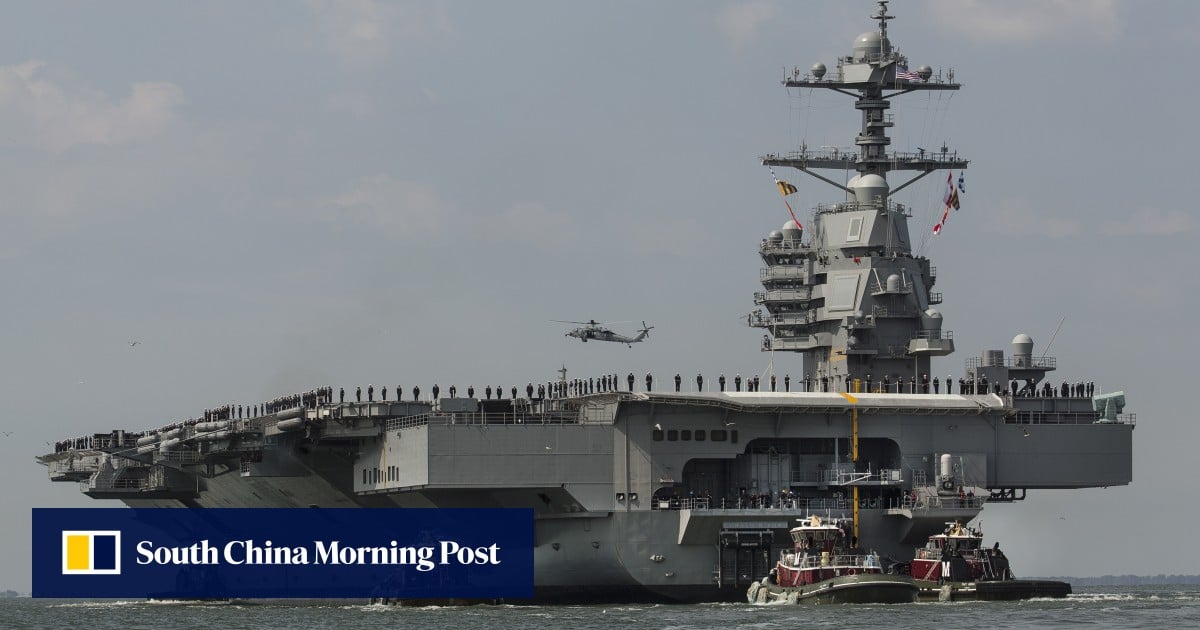- cross-posted to:
- worldnews@lemmy.ml
- cross-posted to:
- worldnews@lemmy.ml
oh no China’s being so aggressive I can’t believe they would consider doing such a thing to wholesome US carriers who definitely belong there
“Why won’t they just LET us keep our weapons of mass destruction there???”
A simulated war-game has pitted Chinese hypersonic weapons against the US Navy’s newest aircraft carrier the USS Gerald R. Ford. Photo: AP
Hypersonic weapons could be “catastrophic” for the most potent aircraft carrier group in the US fleet, according to war game simulations run by a team of military planners in China.
Over 20 intense battles, Chinese forces sank the USS Gerald R. Ford carrier fleet with a volley of 24 hypersonic anti-ship missiles, in a simulation run on a mainstream war game software platform used by China’s military.
In the scenario, the US vessels are attacked after continuing to approach a China-claimed island in the South China Sea despite repeated warnings.
A paper detailing the war game was published in May by the Chinese-language Journal of Test and Measurement Technology. It is the first time the results of simulated hypersonic strikes against a US carrier group have been made public.
The researchers, led by Cao Hongsong from the North University of China, said almost every US surface vessel was shattered by the attack and eventually sank in the simulation.
The war games suggested the US carrier group – previously regarded as unsinkable by conventional weapons – could be “destroyed with certainty” by a relatively small number of hypersonic strikes, they said. In the simulation, Chinese forces launched 24 hypersonic anti-ship missiles from six sites ranging from southern China to the Gobi desert. Illustration: North University of China In the simulation, Chinese forces launched 24 hypersonic anti-ship missiles from six sites ranging from southern China to the Gobi desert. Illustration: North University of China
The team said two hypersonic anti-ship missile models with vastly different performances were unleashed in the simulation, with some launched from as far away as the Gobi Desert.
The Chinese military displayed “unusual prowess in their sophisticated launch strategy” which consisted of an intentionally complex three-wave attack meant to deceive and overcome the formidable defence systems of the US carrier group, the paper said.
Military planners use sophisticated war game simulations to evaluate various scenarios and develop strategies but they cannot be relied on over real-world testing and evaluation.
Some military experts caution that the real-world performance of these missiles may differ from what is predicted by simulations due to terrain, weather, and other unforeseeable factors.
It therefore remained critical for government leaders and the public to approach these simulations with caution and realism, the researchers said. Can China thwart US hypersonic missile defence systems with an old algorithm? 29 Apr 2023
The US fleet in the war game was made up of six surface ships, chosen for their “unparalleled strength and advanced technology”.
The military planners selected vessels deemed the US Navy’s most superior – the CVN-78 Gerald R. Ford, accompanied by a CG56 Ticonderoga-class cruiser the San Jacinto, and four DDG-103 Arleigh Burke-class Flight IIA guided missile destroyers.
The Ford-class carrier, commissioned in July 2017, boasts exceptional technology and design advancements, according to the researchers. Features include a pioneering electromagnetic launch system and state-of-the-art radar and electronic warfare systems.
These sophisticated technologies detect incoming threats while multiple layers of armour and protective systems are designed to lessen the impact of missile attacks and other enemy firepower.
The strike group’s cruisers and destroyers were also equipped with advanced weapons and defensive measures, including radar systems that could detect incoming threats while simultaneously tracking multiple targets, the researchers said.
The war game’s parameters for the carrier group’s total number of air-defence missiles were set at 264, according to the research paper. These included the RIM-161E SM-3, an advanced missile devised to intercept ballistic missiles either in midcourse or terminal phase.
Notably, the SM-3 uses a kinetic warhead to obliterate a target by colliding with it at immense speed. While there is no record of it shooting down a hypersonic threat, the war game designers assumed its capability and incorporated it into the game.
The carrier group was also equipped with numerous soft defence weapons to combat missile attacks, including decoys, chaff, and flare dispensers. The advanced SM-3 missile has been designed to intercept ballistic missiles either in midcourse or terminal phase. Photo: US Navy The advanced SM-3 missile has been designed to intercept ballistic missiles either in midcourse or terminal phase. Photo: US Navy
Several constraints were placed on the Chinese military in the simulation, such as a lack of access to spy satellites stationed in space and a limited number of hypersonic missiles.
The underlying principle of the war game was to be “lenient with the enemy and strict with oneself”, Cao said.
The two models of anti-ship missiles used by the Chinese side in the simulation could cruise at high altitudes and reach a top speed of Mach 11, the paper said. According to Cao, both models are capable of sinking a carrier or large warship within two hits.
The research paper outlined the operational range of one model at 2,000km (1,240 miles) with an 80 per cent probability of hitting its intended target. The other Chinese model has double the range and a higher success rate of 90 per cent. Chinese hypersonic weapons test ‘has all of our attention’, US General Mark Milley says
While the authenticity of the data used in the war games cannot be independently verified, some military experts suggested the information on the weapons’ performance appeared to be reliable.
“The accuracy of the data used in war game simulations is critical to their usefulness in evaluating potential scenarios,” said a Beijing-based aerospace defence industry engineer who asked not to be named because of the issue’s sensitivity.
“If the data about Chinese hypersonic missiles used in this war game simulation is far from reality, it could affect the quality of the simulation and lead to inaccurate conclusions.” British chair professor joins China’s hypersonic programme 13 May 2023
The researchers assumed that the cost of a missile is influenced by the materials, as well as the propulsion and guidance systems, used in its construction, suggesting the model with the greater range and accuracy may be relatively more expensive.
Employing lower quality missiles for certain parts of the attack would therefore maximise the Chinese weapons’ effectiveness, they said. For instance, the less reliable missiles could be used to lure SM-3s into the air or clear surviving ships after a formal attack.
During the simulation, the PLA used its sea-based surveillance network to detect and identify the US carrier group before firing eight of the less-reliable hypersonic missiles simultaneously from southern and central sites in China, the researchers said.
While some of the missiles were intercepted, the attack depleted the US fleet’s SM-3 munitions. Chinese team says hypersonic engine can hit Mach 9 on low-cost jet fuel 18 Nov 2022
The PLA then launched eight of its more accurate hypersonic missiles from northern and western China, with four focused on the aircraft carrier while the others targeted the destroyers. Two of the less accurate missiles were fired at the cruiser, according to the paper.
“After the attack, four ships survived from the blue [US] team, with the destroyers having the most remaining, on average. The reason is that destroyers contain the most soft defence weapons, specially designed to defend against missile attacks,” it said.
Among soft defence weapons, electronic warfare systems play a crucial role in jamming enemy radar signals, a tactic that disrupts the missiles’ ability to lock onto their intended targets.
Other measures such as chaff and flare dispensers create confusion among incoming missiles, either through metallic or plastic strips or by emitting infrared flares that mimic the ship’s heat signature. China’s military simulates precision strikes on Taiwan after island’s leader returns from US visit
04:17
China’s military simulates precision strikes on Taiwan after island’s leader returns from US visit China’s military simulates precision strikes on Taiwan after island’s leader returns from US visit
After confirming the status and location of the remaining targets, the PLA launched a “mop-up” operation with six of the relatively less accurate hypersonic missiles from the southern sites, the paper said.
After running the war game simulation 20 times to consider the various uncertainties that can occur in battle, Cao’s team determined the three-wave attack is capable of eliminating an average 5.6 out of six surface vessels – resulting in “total destruction” of the carrier group.
The researchers said the use of lure tactics would be critical to increasing the effectiveness of China’s hypersonic anti-ship missiles while reducing the number of SM-3 defence missiles available to the US fleet.
The team also said the use of patrol missions to identify and prioritise targets ahead of additional waves of missiles would allow the PLA to conserve is ammunition and ensure it only targeted viable threats.
The reasons for China’s release of the war game results remain unknown. Cao, an experienced researcher on virtual simulation technology and intelligent control technology for missiles and rockets, could not be reached for comment.
Her university, in Taiyuan, Shanxi province, has strong ties to the military with a notable number of its graduates working in the aerospace defence industry, according to publicly available information.
The Journal of Test and Measurement Technology, which published the paper, operates jointly with the university and the China Ordnance Society. Chinese team reveals hypersonic weapons breakthrough for aircraft carrier 11 Oct 2022
The Chinese government has repeatedly accused the US of stoking tensions in the region, especially at China’s doorstep, while Washington has stepped up its military presence in Asia to safeguard “freedom of navigation”.
The Beijing-based researcher said “greater transparency about China’s military capabilities and intentions could help to reduce misunderstandings and miscalculations on both sides, which could in turn help to reduce the risk of conflict”.
“Increasing transparency could also help build trust between China and other countries in the region, which could contribute to greater stability over the long term,” he said. Conversations (219) Stephen Chen
Stephen Chen
- FOLLOW
Stephen Chen investigates major research projects in China, a new power house of scientific and technological innovation. He has worked for the Post since 2006. He is an alumnus of Shantou University, the Hong Kong University of Science and Technology, and the Semester at Sea programme which he attended with a full scholarship from the Seawise Foundation. Science
Can China thwart US hypersonic missile defence systems with an old algorithm? 29 Apr 2023
CG56 Ticonderoga-class cruiser the San Jacinto, and four DDG-103 Arleigh Burke-class Flight IIA guided missile destroyers.
USS San Jacinto, comissioned 1988, never had significan modification, US Navy marked it for decomissioning in 2022 and again in 2023. Arleigh Burke IIA are more modern, being comissioned from 2000, but still whatever algorithm China used for the simulation is newer than those ships.
Unfortunately, the US will be sending the fleets of it’s puppet states first. But maybe this message will make those puppets say, ‘Hold the fuck on for just a minute, there, Sam.’
I definitely think publishing this is meant as a warning for US
I agree with that. I hope we never have to see whether China would retaliate against the US if it kicked things off in Taiwan or sent another state in as a proxy war.
Edit: I’ve just noticed something else, too. There’s a lot of detail about a 2000km range. Taking out ships from the desert, etc. No reason why those missiles couldn’t go in other directions. So I see what you’re saying more clearly now. If the US did cause a proxy war and it was clear the US was behind it, the US isn’t safe. Scary times.
Yeah exactly, China is saying that they can hit US assets anywhere and US has no defense against this. If US is crazy enough to push China into war then they go down as well. Of course, given what we’re seeing in Ukraine right now it’s pretty clear that US political class is batshit insane.
I hope we never have to see whether China would retaliate against the US
As much as i would love seeing the famed carrier groups being stomped flat i much more hope they can peacefully rust somewhere on the ship graveyard.
Also note how one of the conditions was the lack of satelite guidance which as far as i understand it is major factor in such long range attacks, especially with such missiles. And they still annihilated the group with no problem.
I hope they are underselling their capabilities here. If they can reliably guarantee against US intervention in the region it would be huge.
Pretty much every war game US has run showed them losing as well. The reality is that China is playing on the home field here, they can literally launch missiles right from the mainland. Meanwhile, US doesn’t actually have a foothold, they’re at a fundamental disadvantage in terms of logistics.
War between China and US by 2025 anyone?
Well I wasn’t planning on dying in nuclear fire, but it seems almost inevitable now
Hey, look at the bright side: No worries about retirement!
Well I had none since Putin raised the retirement age anyway
A YouTube link was detected in your comment. Here are links to the same video on Invidious, which is a YouTube frontend that protects your privacy:
How do they run war games anyway?
The article says that they have a simulation software in which they simulated American warships advancing despite repeated warnings.
I’ve never actually looked into it. I’m guessing they figure out real world stats for different types of equipment best they can, and then just play a board game with them to try different approaches out and see what happens.
Harpoon game XD
ka-boom
Hypersonic missiles that have countless countermeasures (even if most have low success rate on their own) against them and are expected? Geordi no meme
Communist dark arts super-weapons consisting of sea-floor mounted super-torpedoes with mini-nukes (or conventional explosive equivalent) designed to shoot up from below, target the underside of the aircraft carrier and detonate to break its back in the water and cripple and sink it. Geordi point yes meme
Hypersonic torpedoes beneath the surface and thus immune to most air-based intercept systems and countermeasures (somehow) Wrestling guy soy-facing meme
Though this is an interesting simulation. I’d be interested to know what China plans to do about US submarines. Or that they have a plan, obviously I don’t think they should reveal it and give the game away to the west but I hope it’s been given serious thought and not waved away as unimportant because they don’t want to fight massive sea battles and hold areas of the sea. Obviously preventing them from lurking near the Chinese coast and giving the US ideas about nuking China and catching them with their pants down by eliminating C&C of their military before China can respond will be very attractive to a humiliated US after any loss so it must be deterred. More than that though the US uses subs to deploy and recover special operations soldiers. If we’re talking Taiwan and China stops air-lifts (plausible) they’d use one to evac their puppet regime in Taipei and I wouldn’t even put it beyond them using them for terrorist strikes (blowing up/burning down museums, terror tactics, dumping tons of guns and other weapons for stay-behind cell operations, etc). They’d definitely have 3 or more in the area when they start the Taiwan shit (as it will be the US who chooses the time unfortunately).
one can only hope that war games are accurate. they rely on untested technology. so far, no hypersonic missile has actually been used against an aircraft carrier.
We did see them successfully used against Patriot systems though.
they were?
Yeah, Russia says they’ve destroyed the radar and five launchers. There’s also a video of it firing 30 missiles in 2 minutes failing to stop the kinzhal missile. And US admits that they were hit, but trying to play it down https://www.reuters.com/world/europe/patriot-missile-defense-system-ukraine-likely-damaged-us-sources-2023-05-16/
Is there a non paywall article?
I don’t see a paywall (it probably depends on the country), but this might work
Sort by “hot” and read the top comment














